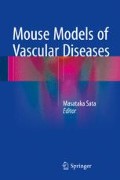Abstract
Recent clinical trials have revealed high rates of delayed restenosis and hemorrhage in angioplasty and stenting in intracranial atherosclerotic diseases, but the causes of this are still unclear. These unfavorable results may be caused by unique properties of intracranial internal carotid arteries (IICAs) such as lack of an external elastic lamina and presence of surrounding cerebrospinal fluid. Clarification of the mechanism of remodeling after vascular injury to IICAs using injury models is needed, although several studies have clarified the pathophysiology and molecular mechanisms involved in the remodeling process after injury to extracranial arteries. In this section, a detailed protocol for an IICA injury (IICAI) model is summarized. We also review the intraluminal suture middle cerebral artery occlusion (MCAo) model in mice, which causes cerebral infarction in the area of the middle cerebral artery region, because the IICAI model is a modification of the intraluminal suture MCAo model.
Access this chapter
Tax calculation will be finalised at checkout
Purchases are for personal use only
References
Jeng J-S, Tang S-C, Liu H-M. Epidemiology, diagnosis and management of intracranial atherosclerotic disease. Expert Rev Cardiovasc Ther. 2010;8:1423–32.
Schumacher HC, Meyers PM, Higashida RT, Derdeyn CP, Lavine SD, Nesbit GM, Sacks D, Rasmussen P, Wechsler LR. Reporting standards for angioplasty and stent-assisted angioplasty for intracranial atherosclerosis. J Vasc Interv Radiol. 2009;20:S451–73.
Arenillas JF, Molina CA, Chacón P, Rovira A, Montaner J, Coscojuela P, Sánchez E, Quintana M, Alvarez-Sabín J. High lipoprotein (a), diabetes, and the extent of symptomatic intracranial atherosclerosis. Neurology. 2004;63:27–32.
Chen S, Hanel RA. The final SAMMPRIS results: a review. World Neurosurg. 2014;82:5–6.
Stenting of Symptomatic Atherosclerotic Lesions in the Vertebral or Intracranial Arteries (SSYLVIA): study results. Stroke. 2004;35:1388–92.
Gröschel K, Schnaudigel S, Pilgram SM, Wasser K, Kastrup A. A systematic review on outcome after stenting for intracranial atherosclerosis. Stroke. 2009;40:e340–7.
Gupta R, Al-ali F, Thomas AJ, Horowitz MB, Barrow T, Vora NA, Uchino K, Hammer MD, Wechsler LR, Jovin G. Drug-Eluting Stent Placement in the Intracranial. Stroke. 2006. doi:10.1161/01.STR.0000242481.38262.7b.
Fields JD, Petersen BD, Lutsep HL, Nesbit GM, Liu KC, Dogan A, Lee DS, Clark WM, Barnwell SL. Drug eluting stents for symptomatic intracranial and vertebral artery stenosis. Interv Neuroradiol. 2011;17:241–7.
Chimowitz MI, Lynn MJ, Derdeyn CP, et al. Stenting versus aggressive medical therapy for intracranial arterial stenosis. N Engl J Med. 2011;365:993–1003.
Walmsley JG, Canham PB. Orientation of nuclei as indicators of smooth muscle cell alignment in the cerebral artery. Blood Vessels. 1979;16:43–51.
Lee RM. Morphology of cerebral arteries. Pharmacol Ther. 1995;66:149–73.
Shimamura M, Nakagami H, Sata M, et al. Unique remodeling processes after vascular injury in intracranial arteries: analysis using a novel mouse model. J Cereb Blood Flow Metab. 2013;33:1153–9.
Caso JR, Pradillo JM, Hurtado O, Lorenzo P, Moro MA, Lizasoain I. Toll-like receptor 4 is involved in brain damage and inflammation after experimental stroke. Circulation. 2007;115:1599–608.
Kim HA, Whittle SC, Lee S, Chu HX, Zhang SR, Wei Z, Arumugam TV, Vinh A, Drummond GR, Sobey CG. Brain immune cell composition and functional outcome after cerebral ischemia: comparison of two mouse strains. Front Cell Neurosci. 2014;8:365.
Shimamura M, Nakagami H, Osako MK, Kurinami H, Koriyama H, Zhengda P, Tomioka H, Tenma A, Wakayama K, Morishita R. OPG/RANKL/RANK axis is a critical inflammatory signaling system in ischemic brain in mice. Proc Natl Acad Sci U S A. 2014;111:8191–6.
Shimamura M, Sato N, Oshima K, Aoki M, Kurinami H, Waguri S, Uchiyama Y, Ogihara T, Kaneda Y, Morishita R. Novel therapeutic strategy to treat brain ischemia: overexpression of hepatocyte growth factor gene reduced ischemic injury without cerebral edema in rat model. Circulation. 2004;109:424–31.
Shimamura M, Taniyama Y, Katsuragi N, Koibuchi N, Kyutoku M, Sato N, Allahtavakoli M, Wakayama K, Nakagami H, Morishita R. Role of central nervous system periostin in cerebral ischemia. Stroke. 2012;43:1108–14.
Kurinami H, Sato N, Shinohara M, Takeuchi D, Takeda S, Shimamura M, Ogihara T, Morishita R. Prevention of amyloid beta-induced memory impairment by fluvastatin, associated with the decrease in amyloid beta accumulation and oxidative stress in amyloid beta injection mouse model. Int J Mol Med. 2008;21:531–7.
Shan J, Nguyen TB, Totary-Jain H, Dansky H, Marx SO, Marks AR. Leptin-enhanced neointimal hyperplasia is reduced by mTOR and PI3K inhibitors. Proc Natl Acad Sci U S A. 2008;105:19006–11.
Author information
Authors and Affiliations
Corresponding author
Editor information
Editors and Affiliations
Rights and permissions
Copyright information
© 2016 Springer Japan
About this chapter
Cite this chapter
Shimamura, M. et al. (2016). A Model of Stroke and Vascular Injury in the Brain. In: Sata, M. (eds) Mouse Models of Vascular Diseases. Springer, Tokyo. https://doi.org/10.1007/978-4-431-55813-2_14
Download citation
DOI: https://doi.org/10.1007/978-4-431-55813-2_14
Published:
Publisher Name: Springer, Tokyo
Print ISBN: 978-4-431-55811-8
Online ISBN: 978-4-431-55813-2
eBook Packages: MedicineMedicine (R0)

